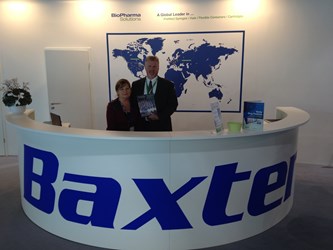Baxter CEO Wants To Cut Costs, Drive Innovation, Make Small Deals
By Jof Enriquez,
Follow me on Twitter @jofenriq

Baxter's newly appointed CEO Jose Almeida plans to accelerate cost-cutting measures and to reallocate savings toward investments that drive innovation. He also prefers to execute smaller acquisitions in the near-term, while leaving the door open for larger deals in the long-term.
Almeida told analysts recently that Baxter will "double down" on cutting expenses by consolidating facilities, switching manufacturing locations to achieve scale and restructuring operations, reports the Chicago Tribune.
"We are aggressively examining our cost structure in terms of how we do business from manufacturing and operations to commercial and corporate infrastructure," Almeida said during the company’s fourth quarter earnings call. "We will reallocate investments based on the ability to drive innovation. In addition, we're intensifying our focus on both R&D velocity and productivity to support our top and bottom line growth initiatives."
Almeida said Baxter's R&D budget is not underfunded, but capital needs to be reallocated to the right franchise with strong growth potential. He highlighted as key growth drivers the company's newly-launched SIGMA SPECTRUM infusion pump and the FDA-cleared AMIA automated peritoneal dialysis (APD) cycler with SHARESOURCE two-way connectivity platform.
For 2016, Baxter hopes to ride the momentum of these new products, which exhibited strong performance in the past quarter, when SIGMA helped propel sales in the infusion systems business by 20 percent, and when AMIA drove up high single digit growth for Baxter's U.S. peritoneal dialysis business.
Almeida said the SIGMA pump has performed well in cybersecurity terms, and that two more versions of the SIGMA pump will be rolling out in a couple of years. As for AMIA, the company is looking forward to expanding its launch in 2016. Almeida also expressed optimism in another renal device under development, the VIVIA home dialysis device. He says the platform has been well received in Europe, and a U.S. trial is underway.
The former Covidien head acknowledges that Baxter's cost-cutting, portfolio optimization, and organic innovation initiatives should be supplemented to drive more innovation at the company, and he remains open to becoming active on the M&A front in the short and long terms to round out Baxter's strategy.
"We understand some of these initiatives on the top line take a little longer, and I have no issues augmenting that with some acquisitions, and I have no problems accelerating our cost reduction rebasing the cost of the company to be able to create momentum until we can get the innovation machine reignited again," he said during the call.
Almeida said both large and small deals are on the table, but he is partial to smaller acquisitions because they can be executed quickly to fit with existing businesses.
"Size is not what matters but the ability, the ability to change the weighted average market growth rate of our businesses is key to us," Almeida told analysts. "When we talk about how to hit it well, we want to change – we want to buy business that they're growing faster than our current based business. That is a pretty obvious thing. The second thing is if we can combine that with good synergistic deal, we'll do it as well. And why do I put a bracket around very large deals? Because very large deals are very difficult to find. We can keep looking for a deal like that. It will take a couple of years versus just creating a really good strategy by looking at adjacencies and pairing good businesses with acquisitions that makes sense."
For the fourth quarter of 2015, Baxter reported income from continuing operations of $190 million, including net after-tax special items totaling $46 million primarily related to costs associated with the spin-off of Baxalta, business optimization initiatives, intangible asset amortization, and Gambro integration efforts. Global sales rose 2 percent to $2.6 billion in the same quarter. For 2016, the company projects sales to increase 2 to 3 percent.
